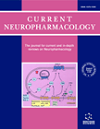- Home
- A-Z Publications
- Current Neuropharmacology
- Previous Issues
- Volume 23, Issue 2, 2025
Current Neuropharmacology - Volume 23, Issue 2, 2025
Volume 23, Issue 2, 2025
-
-
The Role of Alpha-7 Nicotinic Acetylcholine Receptors in Pain: Potential Therapeutic Implications
More LessAuthors: Yu Tao, Yufang Sun, Xinghong Jiang, Jin Tao and Yuan ZhangChronic pain represents a prevalent and costly medical challenge globally. Nicotinic acetylcholine receptors (nAChRs), one type of ligand-gated ion channels found extensively in both the central and peripheral nervous systems, have emerged as promising therapeutic targets for chronic pain. Although there are currently no FDA-approved analgesics specifically targeting nAChRs, accumulating preclinical and clinical evidence s Read More
-
-
-
Protective Role of Electroacupuncture Against Cognitive Impairment in Neurological Diseases
More LessAuthors: Yueyang Xin, Siqi Zhou, Tiantian Chu, Yaqun Zhou and Aijun XuMany neurological diseases can lead to cognitive impairment in patients, which includes dementia and mild cognitive impairment and thus create a heavy burden both to their families and public health. Due to the limited effectiveness of medications in treating cognitive impairment, it is imperative to develop alternative treatments. Electroacupuncture (EA), a required method for Traditional Chinese Medicine, has the pot Read More
-
-
-
Ghrelin, Neuroinflammation, Oxidative Stress, and Mood Disorders: What Are the Connections?
More LessGhrelin is a gut peptide hormone associated with feeding behavior and energy homeostasis. Acylated ghrelin binds to the growth hormone secretagogue receptor 1a subtype (GHS-R1a) in the hippocampus, leading to GH release from the anterior pituitary. However, in recent years, ghrelin and its receptor have also been implicated in other processes, including the regulation of cardiomyocyte function, muscle trophis Read More
-
-
-
Deciphering the Causality between Gut Microbiota Dysbiosis and Poisoning by Narcotics and Psychodysleptics: A Mendelian Randomization Analysis
More LessBackgroundThis study investigates the connection between gut microbiota and poisoning caused by narcotics and psychodysleptics, using Mendelian randomization (MR) to explore possible causal relationships.MethodsThe study employed the MR analysis, leveraging genetic variants as instrumental variables to facilitate robust causal inference. Data for gut microbiota was extracted from the MiBioGen study, integrating Read More
-
-
-
Time- and Region-specific Effect of Vortioxetine on Central LPS-induced Transcriptional Regulation of NLRP3 Inflammasome
More LessBackgroundInflammasome overactivation, multiprotein complexes that trigger inflammatory responses, plays a critical role in Major Depressive Disorder (MDD) pathogenesis and treatment responses. Indeed, different antidepressants alleviate depression-related behaviours by specifically counteracting the NLRP3 inflammasome signalling pathway. The immunomodulatory effects of vortioxetine (VTX), a multimodal antidepr Read More
-
-
-
MiRNA Dysregulation in Brain Injury: An In Silico Study to Clarify the Role of a MiRNA Set
More LessBackgroundThe identification of specific circulating miRNAs has been proposed as a valuable tool for elucidating the pathophysiology of brain damage or injury and predicting patient outcomes.ObjectiveThis study aims to apply several bioinformatic tools in order to clarify miRNA interactions with potential genes involved in brain injury, emphasizing the need of using a computational approach to determine the mo Read More
-
-
-
Comparison of the Antianhedonic Effects of Repeated-dose Intravenous Ketamine in Older and Younger Adults with Major Depressive Episode
More LessAuthors: Wei Zheng, Limei Gu, Jianqiang Tan, Yanling Zhou, Chengyu Wang, Xiaofeng Lan, Bin Zhang, Zezhi Li and Yuping NingObjectivesGrowing evidence suggests that repeated-dose intravenous ketamine in patients with depression had rapid antianhedonic effects. However, a comparison of the antianhedonic effects of repeated-dose intravenous ketamine between younger adults and older depressed patients has not been examined.MethodsTo the best of my knowledge, this study with a total of 135 patients with major depressive episodes (MD Read More
-
Volumes & issues
-
Volume 23 (2025)
-
Volume 22 (2024)
-
Volume 21 (2023)
-
Volume 20 (2022)
-
Volume 19 (2021)
-
Volume 18 (2020)
-
Volume 17 (2019)
-
Volume 16 (2018)
-
Volume 15 (2017)
-
Volume 14 (2016)
-
Volume 13 (2015)
-
Volume 12 (2014)
-
Volume 11 (2013)
-
Volume 10 (2012)
-
Volume 9 (2011)
-
Volume 8 (2010)
-
Volume 7 (2009)
-
Volume 6 (2008)
-
Volume 5 (2007)
-
Volume 4 (2006)
-
Volume 3 (2005)
-
Volume 2 (2004)
-
Volume 1 (2003)
Most Read This Month
Article
content/journals/cn
Journal
10
5
false
en


